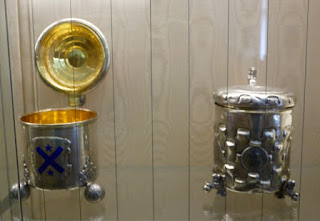 |
| These are Freakin' Amazing! |
So here we go:
First: Clean and sterilize 6 half pint wide mouth Mason jars with their lids and preheat your water bath to 80° C.
Step 1: Make the Graham Cracker Crust
First: Clean and sterilize 6 half pint wide mouth Mason jars with their lids and preheat your water bath to 80° C.
Step 1: Make the Graham Cracker Crust
 |
| Yep, that's six - you only need five |
Graham Cracker Crust
Ingredients
- 5 Graham Crackers
- 25 Grams Sugar
- 60 Grams Butter
- Tare the butter and sugar into the Thermomix bowl and process at 50° C until the butter is melted and the sugar well combined.
- Break up the Graham Crackers and add to the butter mixture. Process on Speed 5 until ground to a coarse meal texture. If it doesn't hold together when you squeeze some in your hand, just add a little more melted butter.
- Transfer the mixture to a bowl and set aside.
- Clean and dry the Thermomix bowl.
 |
| There's Butter Down In There... |
Cheesecake Batter
Ingredients
- 25 grams Butter
- 220 Grams Ricotta
- 220 Grams Philadelphia Cream Cheese (1 pkg.), cut up
- 150 Grams Sugar
- 2 Large Eggs
- 15 grams AP Flour
- 15 Grams Corn Starch
- 1.5 tsp.Vanilla Extract
- 220 Grams Sour Cream
- Tare the butter into the Thermomix bowl and melt at 50° C, Speed Stir.
- Tare the ricotta, cream cheese, and sugar into the bowl and process on Speed 4 until well combined, about 15-20 seconds. Scrape down the sides of the bowl.
- Add the eggs and process on Speed 4 until well combined. Scrape down the sides of the bowl.
- Tare in the flour, cornstarch, and vanilla and process on Speed 4 until well combined. Scrape down the sides of the bowl and ensure than none of the dry ingredients are stuck to the top of the blades.
- Tare in the sour cream and process on Speed 4 until the mixture is perfectly smooth.
Divide the Graham Cracker mixture among the 6 Mason jars, pressing it down with your fingers.
Pour in the Cheesecake batter leaving a half inch head space. This is important as the mixture will expand as it cooks and you don't want to have to clean cheesecake goop out of your circulator.
Carefully wipe the rims and seal the jars "hand tight". This is actually just a little tighter than you would for pressure canning.
If you have some left over batter, just add it to another jar.
Gently drop the jars into the preheated water bath and cook for 2 hours. Note that as they warm up you'll see some bubbles as the air and cheesecake mixture expands. You're OK as long as you left a head space.
 |
 |
| Have A Bite! |





















































